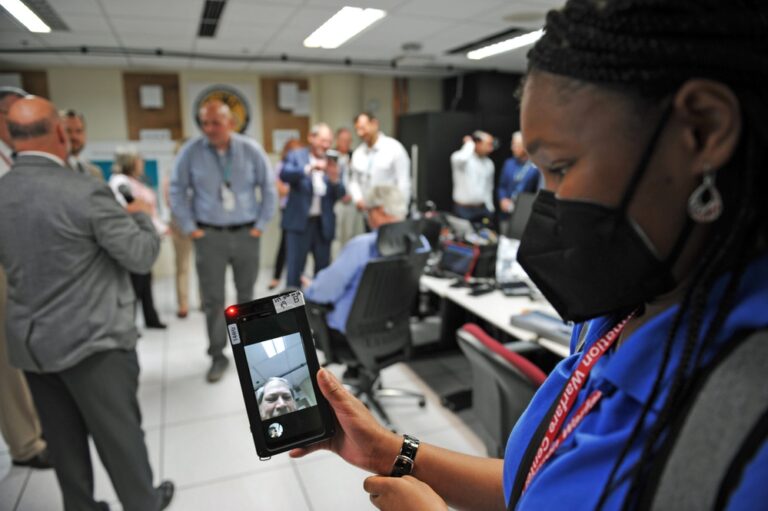The U.S. Navy fleet may soon begin to benefit from 5G technology. Over the past few years, in collaboration with the Office of the Under Secretary of Defense, Research and Engineering (OUSD R&E) FutureG Office, the Naval Information Warfare Center (NIWC) Atlantic has been developing and testing 5G capabilities in the Navy ship environment, preparing to deploy those capabilities on U.S. Navy ships. This same technology used by nearly every civilian with a cell phone is poised to impact the quality of life and work on board, known as Quality of Service (QoS), for sailors.
This new shipboard 5G technology began development about five years ago at NIWC Atlantic’s Assured Real-Time Communications (ARC) laboratory in Norfolk, which focuses on joint interoperability and cybersecurity.
While Wi-Fi technology has been piloted and used successfully in the Navy recently, including on the USS Abraham Lincoln (CVN 72)’s Sailor Edge Afloat and Ashore, NIWC Atlantic engineers are working to implement 5G technology both at sea and on shore to make Wi-Fi and other technologies more effective, efficient, and secure. Ultimately, NIWC Atlantic’s 5G implementation efforts will result in higher levels of security and performance, improving overall QoS.
“The work that NIWC Atlantic (5G) engineers have done with our industry partners has laid a solid engineering foundation for the potential proliferation of 5G technology across the Navy,” said Peter Reddy, executive director of NIWC Atlantic. “While the use cases addressed here were shipboard and dockside, there are many other use cases that 5G will meet across the Department of the Navy.”
The work NIWC Atlantic is doing with 5G technology has to do with improving QoS. “We’re trying to leverage that technology. [QoS] In developing our engineering processes, we look for solutions that meet our customers’ needs. [common communication capabilities such as] “The technology also offers features like gaming and FaceTime, allowing sailors to be present at the birth of a child, and now addresses the security challenges that come with command-and-control type communications,” said Kevin Thompson, NIWC Atlantic senior engineer and test director for the Assured Real-Time Communications (ARC) laboratory.
However, in the early stages, NIWC Atlantic was not able to test the technology in a real ship environment without disrupting Navy activities and operations. Fortunately, in 2021, the Iowa-class battleship USS Wisconsin (BB 64), currently serving as a museum ship docked in Norfolk, Virginia, reached out to NIWC Atlantic’s Norfolk 5G team to ask if they had a replacement part for one of their messaging systems. Over time, a meaningful relationship was developed between the museum ship’s crew and the NIWC Atlantic 5G team that continued to develop, eventually giving the 5G team the opportunity to request and begin testing 5G on the USS Wisconsin.
Testing by the NIWC Atlantic Norfolk 5G team on board the USS Wisconsin was critical to the success of 5G technology. NIWC Atlantic engineers deployed a private 5G core to test 5G coverage and performance in the ship’s interior space. Ultimately, they found that 5G propagation within the confined interior space was excellent and consistent with previous test results.
But handling 5G data hasn’t always been smooth sailing. Because ships face unique radio frequency (RF) spectrum and security challenges, and 5G technology is a common technology field used for a variety of purposes, the 5G team found it difficult to predict whether commercial 5G solutions would work as expected in the Navy’s operating environment.
5G technology also comes in different maturity levels. “That means as we start to think about how to implement solutions that leverage 5G for quality of work and quality of life, we’re taking two different systems and trying to figure out how to agree on a common infrastructure that can support both,” Thompson said.
Still, NIWC Atlantic has been working hard to overcome the various challenges associated with 5G data. Thompson said NIWC Atlantic continues to come up with collaborative solutions to ensure 5G works well on all devices and systems. Currently, NIWC Atlantic is working to improve and maintain relationships with various program offices to help implement 5G technology into existing systems.
Arnel Castillo, a senior engineer who serves as program manager (PM) for NIWC Atlantic’s 5G prototyping effort, explained that these relationships are crucial: “You have to be able to respect the process that’s currently in place, so that as we deploy this technology there’s some familiarity and confidence that we’re not completely changing the paradigm,” Castillo said.
To date, the NIWC Atlantic 5G team has achieved numerous advancements in 5G technology, including the development of reference architectures for ship-wide, coastal, open sea, pier-side and onshore operational domains.
The team also designed and implemented the Department of Defense (DoD) maritime 5G multi-vendor (ship-based and pier-side networks) testbed, enabling 5G network and user equipment (UE) experimentation over a wide range of 5G frequencies.
Additionally, they implemented the Department of Defense’s first Voice over New Radio (VoNR) and Video over New Radio (ViNR) private 5G network, which is especially popular with Navy soldiers because it offers better QoS.
According to both Castillo and Thompson, 5G technology holds a promising future for all Navy personnel. Not only will the technology, now ubiquitous in cellphones, soon transform communications and connectivity for every Navy ship at sea and ashore, but the “Get Real Get Better” initiative will help give leaders and problem solvers a nearly limitless warfighting advantage.
“Thanks to the great work of this team, the Navy is now extremely prepared to move quickly to rapidly expand 5G capabilities across the fleet,” Reddy said.
| Date of photo: | June 28, 2024 |
| Posted on: | July 1, 2024 08:01 |
| Story ID: | 475205 |
| position: | Norfolk, Virginia, USA |
| Web view: | 457 |
| download: | 0 |
Public domain

This work is, NIWC Atlantic develops 5G technology for fleet-wide usemust comply with the restrictions set forth at https://www.dvidshub.net/about/copyright.


